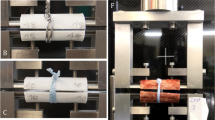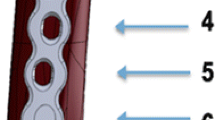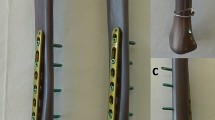Abstract
Purpose
Cerclage technology is regaining interest due to the increasing number of periprosthetic fractures. Different wiring techniques have been formerly proposed and have hibernated over years. Hereby, they are compared to current cerclage technology.
Methods
Seven groups (n = 6) of different cable cerclage (Ø1.7 mm, crimp closure) configurations (one single cerclage looped once around the shells, one single cerclage looped twice, two cerclages each looped once) and solid wire cerclages (Ø1.5 mm, twist closure) (same configurations as cable cerclages, and two braided wires, twisted around each other looped once) fixed two cortical half shells of human femoral shaft mounted on a testing jig. Sinusoidal cyclic loading with constantly increasing force (0.1 N/cycle) was applied starting at 50 N peak load. Cerclage pretension (P), load leading to onset of plastic deformation (D) and load at total failure (T) were identified. Statistical differences between the groups were detected by univariate ANOVA.
Results
Double looped cables (P442N ± 129; D1334N ± 319; T2734N ± 330) performed significantly better (p < 0.05) than single looped cables (P292N ± 56; D646N ± 108; T1622N ± 171) and were comparable to two single cables (P392N ± 154; D1191N ± 334; T2675N ± 361). Double looped wires (P335N ± 49; D752N ± 119; T1359N ± 80) were significantly better (p < 0.05) than single looped wires (P181N ± 16; D343N ± 33; T606N ± 109) and performed similarly to single looped cables. Braided wires (P119N ± 26; D225N ± 55; T919N ± 197) exhibited early loss of pretension and plastic deformation.
Conclusion
Double looped cerclages provided a better fixation stability compared to a single looped cerclage. Double looped wires were comparable to a single looped cable. The use of braided wires could not be recommended mechanically.
Similar content being viewed by others
Avoid common mistakes on your manuscript.
Introduction
Cerclage technology has regained acceptance due to the increasing number and demands of periprosthetic hip fractures. As a stand-alone implant, cerclages are usually too weak to fulfill the requirements of functional aftercare. An internal plate or endoprosthesis shaft provides splinting as the major element stabilising the fracture while the cerclage reduces and fixes the fragments exerting additional stability via a centripetal force [1]. Broken cerclages with the consequent loss of fracture reduction or risk of migration remain a surgical problem [2]. Wire cerclages are more susceptible to loss of pretension than cable cerclages closed by a crimp [3, 4]. The cerclage lock remains the weak point, where often failure occurs. A plastically deformed twist enhances the fixation capacity [4], but the monofilament structure of the wire could be injured by its plastic deformation or repetitive bending. A break point could be setup during the twisting procedure [2]. Wire cerclage failure mainly occurs at the innermost turn of the twist [4]. Using cable cerclages, the multifilament structure of the cable could be damaged by the crimp with cable rupture at the crimp [5]. Techniques which lower the tension on the cerclage lock and enhance the load resistance of the cerclages have to be considered. Looping the cerclage twice around the bone enhances the cerclage tension, increases the failure load and reduces interfragmentary motion compared to a single cerclage. Due to its improved properties, double looping the wire cerclages is considered the technique of choice in small animal surgery [6].
Nevertheless, the potential of optimised wire cerclage configurations with regard to cable cerclage technology remains unclear. This study compared the mechanical performance of several wire cerclage configurations closed by a twist to different cable cerclage configurations in terms of loss of pretension, load leading to onset of plastic deformation and load at total cerclage failure under cyclic loading.
Materials and methods
Study groups
Fresh-frozen human femoral diaphyseal bones from anonymised donors were thawed and kept humid. Radiographs were taken from the specimens to exclude bone pathologies. Soft tissues were removed prior to testing. Fragments of 50mm length were cut from the mid-diaphysis of the femur, and the intramedullary canal was reamed up to 19 mm. The fragment was cut into two half shells in the coronal plane. To level the influence of bone quality on the results, each specimen was used once for all groups, so that in total six specimens were used in this study.
Stainless steel cable cerclages (Ø 1.7 mm) and stainless steel wire cerclages (Ø 1.5 mm) (Synthes GmbH, Solothurn, Switzerland) were investigated in this study, focusing on cerclage application on the femoral shaft, where smaller diameters should not be applied. The cable has a multifilament structure consisting of a central bundle with 19 strands and eight outer bundles with seven strands, whereas the wire has a monofilament structure. The cable was looped around the two bone half shells in three, the wire in four different configurations with six cerclages tested per group as follows: One cerclage looped twice around the bone (double cable, double wire), two cerclages each looped once around the bone (two cable, two wire), one cerclage looped once around the bone (single cable, single wire) and a two-strand braided wire consisting of two 1.5 mm wires looped once around the bone (braided wire). Cables were tensioned by a cable tensioner and closed with a crimp. The crimp is a two-hole side-crimped crimp, where the two ends of the cable are inserted in the opposite direction and closed by three-point bending pliers. Wires were hand-tensioned by pliers and closed with a symmetrical twist, formed under permanent tension during twisting (Fig. 1).
Cerclage configurations. Schematic view of the seven cerclage configurations compared in this study. a One double-looped 1.7-mm cable cerclage closed by a crimp. b Two single-looped 1.7-mm cable cerclages, each closed by a crimp. c One single-looped 1.7-mm cable cerclage closed by a crimp. d One double-looped 1.5-mm wire cerclage closed by a twist. e Two single-looped 1.5-mm wire cerclages, each closed by a twist. f One single-looped 1.5-mm wire cerclage closed by a twist. g Two braided 1.5-mm wire cerclages looped once around the bone and closed by a twist
Mechanical testing
Mechanical testing was performed on a servohydraulic test system (Bionix 858; MTS Systems, Eden Prairie, USA) with a 25 kN load-cell. The diaphyseal cortical half shells were mounted on two custom-made metallic half cylinders with a diameter of 19 mm forming a full cylinder. Each metal half cylinder was fixed to a custom-made frame. The upper frame was rigidly attached to the actuator and the lower frame was affixed to the load cell of the test system (Fig. 2).
Test setup. Cortical half shells mounted on cylindrical metal bars with one 1.5mm wire cerclage double looped around the bone, tightened and closed by a twist. Cyclic loading (blue arrows) tends to separate the half shells against cerclage tension. Wire and cable cerclages were investigated. On the left, the complete test setup-frame is shown with cylindrical metal bars, mounted specimen, load cell at the bottom and the actuator on the top
Contact was established between both half cylinders. Cerclages were looped around the two cortical half shells and manually pretensioned. Cyclic mechanical testing was performed at a rate of 2 Hz under sinusoidal axial tension. The first cycle of the test ranged from 25 N (valley) to 50 N (peak) load. The peak level was then monotonously increased at 0.1 N/cycle until catastrophic failure of the cerclages occurred, while the valley load was maintained constant. The principle of fatigue testing with monotonically increasing load levels has been proven useful previously [7].
Data acquisition and analysis
Axial load and axial displacement were recorded from the test system’s transducers at a frequency of 64 Hz. Construction failure was defined as axial displacement of more than 3 mm. Loss of pretension was defined as onset of gap opening of over 0.05 mm at peak load. Plastic deformation was defined as a permanent gap opening without closure of the fracture gap at load valley (>0.05 mm at load valley). These values were considered reasonable from preceding pilot experiments. Cerclage pretension, load leading to onset of plastic deformation and load at total cerclage failure were determined from the displacement progression of the machine data (Fig. 3).
Load–displacement curve of the test (schematic view). Loss of pretention, load leading to onset of plastic deformation and load at total cerclage failure were determined from the displacement progression of the machine data. Since the load was monotonously increased at every cycle, corresponding force is displayed on the x-axis. Loss of pretension was defined as an onset of gap opening of >0.05 mm at peak load. Plastic deformation was defined as permanent gap opening without closure of the fracture gap at valley load >0.05 mm. Total failure was defined as axial displacement >3 mm
Statistical analysis was performed using SPSS software (IBM SPSS Statistics 20.0.0, USA). Data revealed normal distribution within each group as indicated by the Shapiro-Wilk test. For the detection of significant differences between the groups regarding loss of pretension, point of plastic deformation and total failure, a one-way analysis of variance (ANOVA) with Tukey’s B post hoc correction was performed. Significance level was defined as α = 0.05.
Results
The pretension, load leading to the onset of plastic deformation and the load at total cerclage failure of the different cerclage configurations are displayed in Fig. 4. Within each of these test events statistical subsets were identified for the different groups as indicated in Table 1. Differences between the subsets were statistically significant. Double looped cable and wire cerclages performed significantly better in all tested modalities compared to the corresponding single looped cerclages. Double looped cable cerclages exhibited comparable results to two single-looped cable cerclages. The results of double looped wires were comparable to one single-looped cable. Braided wires exhibited early loss of pretension and plastic deformation.
Pretension, load at onset of plastic deformation and load at total failure. Mean wire tension values for the different cerclage configurations and types are displayed in Newtons (N). Error bars indicate standard deviation. Double-looped cables performed significantly better (p < 0.05) in all tested modalities compared to single-looped cables and were comparable to two cables. Double-looped wires were significantly superior (p < 0.05) in all tested modalities to a single looped wire and performed similarly to single-looped cables. Braided wires exhibited early loss of pretension and plastic deformation. The complete statistical evaluation is given in Table 1
All cerclage wires failed either by unravelling of the twist or by wire breakage at the innermost turn of the twist. Braided wires uniquely failed by unravelling. Cable cerclages failed by cable rupture elsewhere than at the crimp. Neither cable loosening nor failure within the crimp was observed.
Discussion
In this study, we compared different cable and wire cerclage configurations with regard to pretension, load leading to the onset of plastic deformation and load at total failure in an experimental setup. To mimic the clinical loading patterns to which cerclages are exposed, a cyclic loading protocol was applied and half shells of human femoral shafts were mounted on metal bars to provide a more physiological cerclage-bone interface, not considered in previous studies [2, 8], where higher pretension values for cerclage testing were observed on a polysulfone model compared to a human bone model [9].
In our study, pretension was determined under increasing cyclic load by means of its loss, which could be considered as a parameter of clinical interest under load bearing activity and explain differing previous results [9], where pretension was measured directly after cerclage tightening without load application.
Several authors suggested using double-strand braided monofilament wires that withstand higher strength in a pure tensile test [5, 10]. The properties of the twist, its symmetrical winding and plastic deformation determine its holding strength [4]. For a double-strand, braided, 1.5-mm diameter monofilament wire including four strands to be twisted, a higher force has to be applied during tightening and a symmetrical twist, where one end engages the other, cannot be formed. The minor quality of the twist explains the loss of pretension at lower load and the early plastic deformation, which renders its clinical use as a twist-locked cerclage [10] not recommendable.
In contrast to previously observed cable failure at the crimp [5], we observed cable failure elsewhere than at the crimp. In the cable constructions of our study, cerclage rupture is only dependent on the tensile strength of the cable, making a single cable cerclage biomechanically comparable to a double looped wire cerclage and explaining why two cable cerclages performed similarly to one double looped cable cerclage. These results may differ using cables with other locking methods where cerclage failure is seen within the crimp [3].
Adopting the tackle principle to the cerclage application by looping the cerclage twice around the bone, the cerclage itself including the lock is less loaded, making the double-loop technique especially useful for wire cerclages, where failure occurs mainly at the twist. According to the tackle principle, a higher travel during cerclage loosening is required in the double-loop technique compared to a single-loop until loss of pretension occurs. Since the greatest amount of tension is installed at the very last degree of cerclage tightening, correlating in a logarithmic relationship [11] with the amount of travel, the loss of tension, caused by a slight opening in single looped cerclages could be prevented by this principle, resulting in improved pretension maintenance as demonstrated in both double looped cerclage groups. In contrast to previous results [11], we observed that the groups achieving a higher pretension also required a higher load, leading to onset of plastic deformation.
A double-looped cerclage should be considered at locations where improved stability is needed, i.e. in periprosthetic fractures at the point of load transmittance from the prosthesis stem to the bone. The major surgical disadvantage of double-looped cerclage application is its double looping around the bone, so that the surgical procedure necessary for a single-looped cerclage has to be performed twice, irrespective of a minimally invasive or conventional open technique, including the risk of vascular or nerve damage. In dangerous zones, anatomical structures should therefore be visualised before cerclage application.
Cerclages bear forces applied in a centripetal direction [1], holding radially displaced fragments together, as investigated with our test setup, mimicking a fractured bone around an intramedullary implant. A stable fracture reduction is essential in cerclage fixation to achieve additional stability via bone-to-bone contact in the axial direction and also for spiral fractures in torsion. To achieve stability via bone-to-bone contact, an accurate fitting of the fracture fragments and a sufficient and lasting tension of the cerclage is necessary, avoiding movements at the fracture site. Double looping both cable and wire cerclages can significantly enhance the load resistance of the cerclage and improve cerclage fixation. If several cerclages have to be applied along the shaft to fix longitudinal fractures, it is advisable to use single-looped cable cerclages or several double-looped wires, since fixation strength of two single-looped cable cerclages is comparable to one double-looped cable cerclage. A sufficient tension of the cerclage cannot neutralise torsional and bending moments or shear forces [12]. Cerclages should be therefore always combined with internal splinting. If plates are fixed with cerclages, an eyelet should be used to connect the cerclage to the plate and additional screw fixation of the plate is necessary to transmit torsional and bending moments.
Conclusion
Cable cerclages provided an increased fixation strength compared to wire cerclages. By double looping the cerclages the fixation stability can be further enhanced. A double-looped wire cerclage provided a comparable strength to a single cable cerclage. The use of braided wires could not be recommended.
References
Perren SM, Fernandez Dell'Oca A, Lenz M, Windolf M (2011) Cerclage, evolution and potential of a Cinderella technology. An overview with reference to periprosthetic fractures. Acta Chir Orthop Traumatol Cech 78(3):190–199
Bostrom MP, Asnis SE, Ernberg JJ, Wright TM, Giddings VL, Berberian WS, Missri AA (1994) Fatigue testing of cerclage stainless steel wire fixation. J Orthop Trauma 8(5):422–428
Carls J, Kohn D, Rossig S (1999) A comparative study of two cerclage systems. Arch Orthop Trauma Surg 119(1–2):67–72
Wähnert D, Lenz M, Schlegel U, Perren S, Windolf M (2011) Cerclage handling for improved fracture treatment. A biomechanical study on the twisting procedure. Acta Chir Orthop Traumatol Cech 78(3):208–214
Dickman CA, Papadopoulos SM, Crawford NR, Brantley AG, Gealer RL (1997) Comparative mechanical properties of spinal cable and wire fixation systems. Spine (Phila Pa 1976) 22(6):596–604
Johnson A, Houlton J (2005) AO principles of fracture management in the dog and cat. Thieme, Stuttgart
Windolf M, Muths R, Braunstein V, Gueorguiev B, Hänni M, Schwieger K (2009) Quantification of cancellous bone-compaction due to DHS Blade insertion and influence upon cut-out resistance. Clin Biomech (Bristol, Avon) 24(1):53–58. doi:10.1016/j.clinbiomech.2008.09.005
Blass CE, Piermattei DL, Withrow SJ, Scott RJ (1986) Static and dynamic cerclage wire analysis. Vet Surg 15(2):181–184. doi:10.1111/j.1532-950X.1986.tb00200.x
Liu A, O'Connor DO, Harris WH (1997) Comparison of cerclage techniques using a hose clamp versus monofilament cerclage wire or cable. J Arthroplasty 12(7):772–776
Steinberg EL, Shavit R (2011) Braided cerclage wires: a biomechanical study. Injury 42(4):347–351. doi:10.1016/j.injury.2010.05.022
Roe SC (1997) Mechanical characteristics and comparisons of cerclage wires: introduction of the double-wrap and loop/twist tying methods. Vet Surg 26(4):310–316
Wagner M, Knorr-Held F, Hohmann D (1996) Measuring stability of wire cerclage in femoral fractures when performing total hip replacement. In vitro study on a standardized bone model. Arch Orthop Trauma Surg 115(1):33–37
Conflict of interest
The authors were not compensated and there were no other institutional subsidies, corporate affiliations, or funding sources supporting this work unless clearly documented and disclosed.
Author information
Authors and Affiliations
Corresponding author
Additional information
This work was performed at the AO Research Institute Davos, Switzerland.
Rights and permissions
About this article
Cite this article
Lenz, M., Perren, S.M., Richards, R.G. et al. Biomechanical performance of different cable and wire cerclage configurations. International Orthopaedics (SICOT) 37, 125–130 (2013). https://doi.org/10.1007/s00264-012-1702-7
Received:
Accepted:
Published:
Issue Date:
DOI: https://doi.org/10.1007/s00264-012-1702-7








